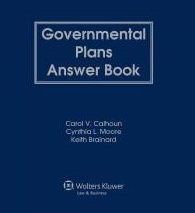Venable LLP
600 Massachusetts Avenue, NW
Washington, DC 20001
Phone: (202) 344-4715
Fax: (202) 344-8300
Mobile: (202) 441-5592
E-mail: Click here to send e-mail.

The Fifth Edition of the Governmental Plans Answer Book has now been published!
Synopsis
Governmental Plans Answer Book, Fifth Edition, provides in-depth coverage of these complex plans, which must satisfy federal laws as well as pension, investment, and other laws of the applicable state or local governments. It is the one resource that takes you step by step through all the aspects of plan administration and compliance in this demanding practice area.
The Fifth Edition of Governmental Plans Answer Book gives subscribers the most relevant, current, and practice-oriented answers to the issues faced daily by plan administrators, attorneys, actuaries, consultants, accountants, and other pension professionals as they navigate the requirements and procedures involved in administering their plans. The Fifth Edition of Governmental Plans Answer Book examines the following significant changes and case law in this area and includes:
- Department of Labor regulations that define who is a fiduciary as a result of rendering investment advice to a plan, or to its participants, or beneficiaries (see Chapter 7).
- Elimination of the ability to obtain Internal Revenue Service (IRS) determination letters on individually designed plans, except on their inception or
termination (see Chapter 4). - Recent legislative developments affecting governmental plans (see Chapter 13).
- Expanded coverage of cases in text cross-referenced to Appendix E, Recent Court Decisions of Interest Involving Governmental Plans (see Appendix E).
- Updates on the size of the public pension community: its membership, assets, rate of participation in different types of retirement plans, and the number of participating public employers (see Chapter 2 and Appendix Table A–1).
- New and updated information regarding public pension financial reporting and communications practices (see Chapter 5).
- Expanded and updated descriptions of hybrid retirement plans provided for employees of state and local government (see Chapter 2 and Appendix Tables A–2 through A–5).
- An examination of how the Bankruptcy Abuse Prevention and Consumer Protection Act of 2005, as further amended by the Bankruptcy Technical Corrections Act of 2010, impacted certain issues arising under the Bankruptcy Code (see Chapter 14).
- Issues concerning proof of electronically signed or adopted beneficiary designation (see Q 12:5).
- A review of a Supreme Court case that held a Chapter 7 trustee could not contest the validity of a claimed exemption after the objection deadline
expired (see Q 14:32). - New case law discussing the use of the legal fiction of a nunc pro tunc order (see Q 13:33).
- Expanded discussion of pre-approved plans (see Chapter 4).
- Issuance of IRS opinion and advisory letters on pre-approved 403(b) plans (see Chapter 4).
- Inception of annual Required Amendments Lists for individually designed plans (see Chapter 4).
- Guidance on correction procedures if a 403(b) plan erroneously excludes participants from making contributions (see Chapter 4).
- Modifications to the Employee Plans Compliance Resolution System (see Chapter 4).
- Expanded discussion on community property (see Q 12:45).
About the Authors:
Carol V. Calhoun
Carol V. Calhoun is counsel at Venable LLP, Washington, DC. A majority of her practice is the representation of state and local retirement systems and other governmental entities in the employee benefits area. She represents clients before the Internal Revenue Service, U.S. Department of Labor, and Pension Benefit Guaranty Corporation, as well as conducting ongoing counseling.
She is the founder and editor of the Employee Benefits Legal Resource Site, https://www.benefitsattorney.com, a legal research source for employee benefits attorneys and other professionals. Ms. Calhoun is the author of a chapter in the 457 Answer Book, published by Aspen, and co-author of the legal analysis section of Tobacco Divestment and Fiduciary Responsibility, A Financial and Legal Analysis, published by the Investor Responsibility Research Center, as well as numerous articles on employee benefits law and insurance product taxation.
Ms. Calhoun is a charter fellow of the American College of Employee Benefits Counsel. She was formerly a member of the Board of Editors of the Legal-Legislative-Regulatory Update section of Benefits Quarterly. She is a member of the American Bar Association Section of Taxation Employee Benefits Committee and formerly chaired its Subcommittees on Governmental Plans; 457, 403(b), and Exempt Organizations Issues; Government Submissions; and Distributions. She is a frequent speaker on employee benefits issues and is a member of the National Association of Public Pension Attorneys and the National Council on Teacher Retirement. Ms. Calhoun received her JD from the Georgetown University Law Center, where she was Associate Editor of The Tax Lawyer. She obtained her BA from The Johns Hopkins University, where she was selected for the Pi Sigma Alpha political science honor society and the Mayor’s Fellow program.
Further information on Ms. Calhoun can be found in the latest edition of Marquis Who’s Who in America.
Cynthia L. Moore
Cynthia L. Moore is an attorney who specializes in issues affecting state and local government retirement systems. She served the National Council on Teacher Retirement (NCTR) as its Washington Counsel by advising NCTR members on federal legislative and regulatory issues that affect the operation of state and local government retirement systems.
Ms. Moore has conducted many surveys on state laws affecting state and local government retirement systems, including those that serve teachers. The surveys cover fiduciary laws, governance, cost of living adjustments, pension portability, and benefit increases.
She has made presentations on pension issues in 43 states and also in Europe to retirement administrators, legislators, governmental officials, active and retired employees, and labor officials.
Before becoming a lawyer, Ms. Moore was a member of former Congressman Dan Glickman’s legislative staff for five years. She covered such diverse issues for him as health, tax, Social Security, and agriculture. She graduated from Case Western Reserve Law School in Cleveland, Ohio. She served as Notes Editor of the Law Review. She is a member of the bar of the Commonwealth of Virginia, the District of Columbia, and the United States Supreme Court.
Keith Brainard
Keith Brainard is the research director for the National Association of State Retirement Administrators (NASRA) and, as such, collects, prepares, and distributes to NASRA members news, studies, and reports pertinent to public retirement system administration and policy. NASRA members are the directors and administrators of 82 statewide public retirement systems in the United States. Combined, these systems hold assets of more than $2 trillion in trust to fund pension and other benefits for most of the 22 million working and retired employees of state and local governments in the United States.
Mr. Brainard is the author of the NASRA white paper “Myths & Misperceptions of Defined Benefit and Defined Contribution Plans,” and co-author of a 2004 Pension Research Council working paper, “Profitable Prudence: The Case for Public Defined Benefit Plans,” which describes the economic effects of public employee pension plans. He also maintains the Public Fund Survey, an online compendium of public pension data sponsored jointly by NASRA and the National Council on Teacher Retirement.
Mr. Brainard previously served as manager of budget and planning for the Arizona State Retirement System, and he provided fiscal research and analysis for the Texas and Arizona legislatures. He has a master’s degree from the University of Texas-Austin, Lyndon B. Johnson School of Public Affairs. He lives with his wife, Katie, and their children in Georgetown, Texas.
Table of Contents
- 1. Introduction to Governmental Plans
- What Is a Governmental Plan?
- Importance of Differences Between Governmental Plans and Private Plans
- 2. Structure of State and Local Governmental Plans
- General Information About State and Local Governmental Plans
- Creating Entity, Governing Law, and Individuals Covered
- Entity That Administers the Plans
- Assets in State and Local Governmental Retirement Plans
- Types of Plans
- Contributions to Fund State and Local Governmental Plans and Employer Pickups
- Protections for the Plans and Their Participants
- Other Issues
- Special Types of Plans
- 3. Identifying the Employer
- Reasons for Identifying the Employer
- Definitions of Employer
- Controlled Group Rules
- Independent Contractors
- Leased Employees
- 4. Obtaining Favorable Tax Status
- Effect of Favorable Tax Status
- Types of Favorable Tax Status
- Requirements for Qualified Plan (Section 401(a)) Status
- Requirements for Qualified Plan (Section 403(a)) Status
- Requirements for Tax-Deferred Annuity or Custodial Account (Section 403(b)) Status
- Requirements for Section 457(b) Status
- Requirements for Excess Benefit Plan (Section 415(m)) Status
- Requirements for Deemed IRA (Section 408(q)) Status
- Pretax Employee Contributions
- IRS Audit Activity
- Correction Procedures
- 5. Reporting
- Purpose of Reporting by State and Local Governmental Plans
- Annual Statement of Member’s Account
- Other Ways in Which Retirement Systems Communicate with Plan Participants
- Summary Plan Description
- Annual Reports
- Open Meetings Laws
- Open Records Laws
- 6. Governmental Plan Funding
- Federal Rules
- Qualified (401(a)) Defined Benefit Plans
- Typical State Rules
- 7. Investment of Plan Assets
- Federal Fiduciary Requirements
- State Fiduciary Requirements
- Federal Prohibited Transaction Rules
- Uniform Management of Public Employee Retirement Systems Act and Uniform Prudent Investor Act
- Legal List Statutes
- Social Investing
- Other State Provisions: Exclusive Purpose Rule, No Diversion of Assets Rule, Anti-Conflict of Interest Statutes, and Codes of Ethics
- Wholly Owned Investments and Investments in Non-Publicly Traded Equity Securities
- Unrelated Business Income Tax Issues
- 8. Selecting a Service Provider
- State Law Issues
- ERISA Analogies
- Practical Steps for Meeting Fiduciary Duties in Choosing a Service Provider
- Breaches of Fiduciary Duty in Selecting a Service Provider
- Modification of Procedures for Selecting a Service Provider
- Fiduciary Duties After a Service Provider Is Selected
- 9. Remedies for Fiduciary Breach
- Criminal Penalties
- Civil Remedies
- Avoiding Fiduciary Liability
- 10. Participation
- Federal Participation Rules
- State Participation Rules
- 11. Distributions
- Common Forms of Distribution
- Federal Restrictions on Distributions
- Definition of Retirement
- Taxation of Distributions
- Rollovers and Plan-to-Plan Transfers
- 12. Beneficiary Designations
- Making a Beneficiary Designation
- Who May Make a Beneficiary Designation?
- Charitable Gifts
- Family Rights That Restrain a Beneficiary Designation
- How Divorce Might Affect a Beneficiary Designation
- Other Events That Might Affect a Beneficiary Designation
- Disclaimers
- Giving Advice About Making a Beneficiary Designation
- Common Mistakes
- 13. Domestic Relations Orders
- Reason for Retirement Plan Domestic Relations Order Provisions
- Elements of a Domestic Relations Order
- Elements of a Plan-Approved Domestic Relations Order
- PADRO Distribution Before a Participant’s Severance
- Survivor Benefits, Beneficiaries, and Loans
- State Variations
- Deciding Whether an Order Is a PADRO
- Plan Administration Procedures
- Tax Treatment of a Distribution Under a Deemed QDRO
- Tax Treatment of an Ineligible Plan’s PADRO Distribution
- Bankruptcy
- Divorce Negotiation
- Lawyer’s Professional Conduct
- 14. Impact of Bankruptcy Law on Participant Interests in Governmental Plans
- Bankruptcy Overview
- Governmental Plan Concerns
- Chapter 7 Considerations
- Chapter 13 Considerations
- Appendices:
- Selected Characteristics of Public Retirement Systems
- Public Fund Survey Summary
- Retirement Eligibility Provisions
- Retirement Factors
- Composition of Public Retirement System Boards
- Uniform Management of Public Employee Retirement Systems Act (1997)
- Uniform Prudent Investor Act
- Federal-State Reference Guide
- Recent Court Decisions of Interest Involving Governmental Plans

